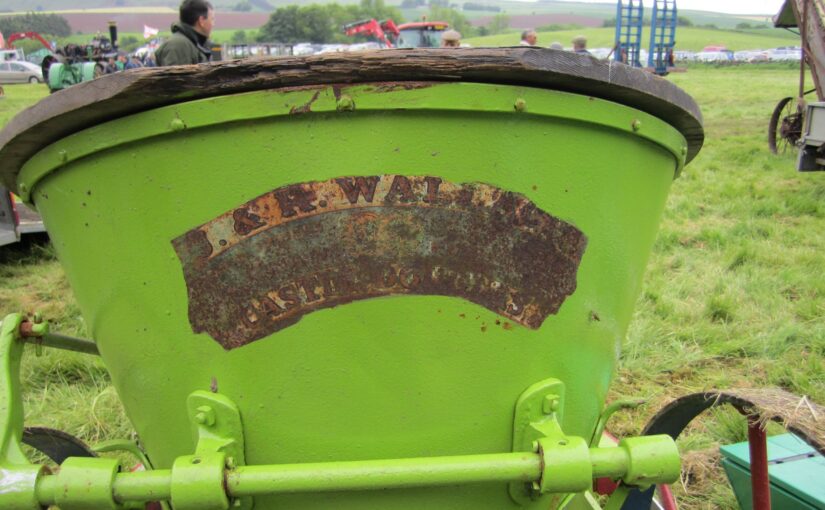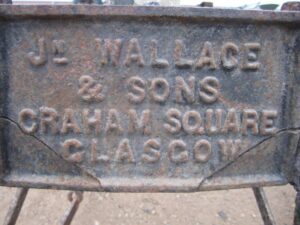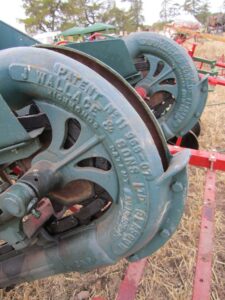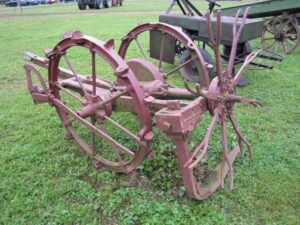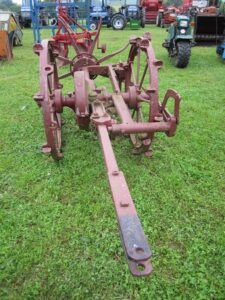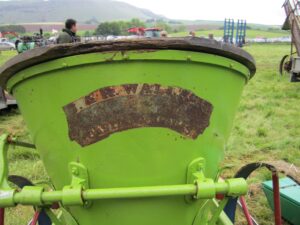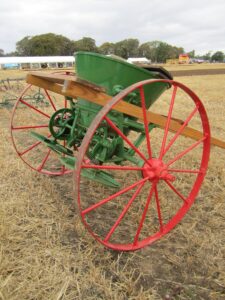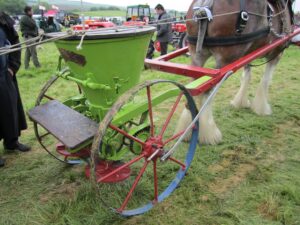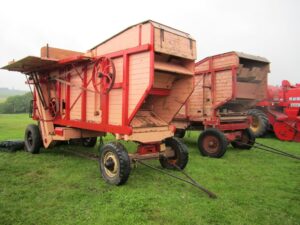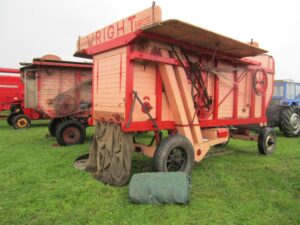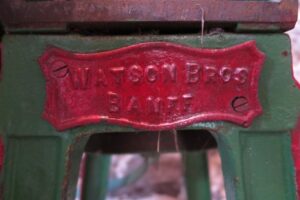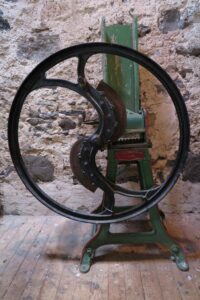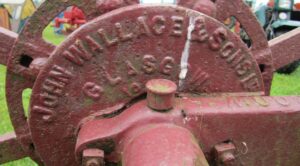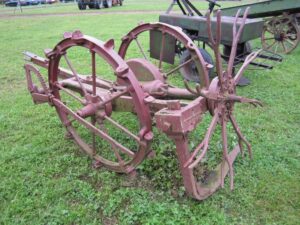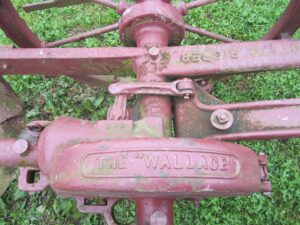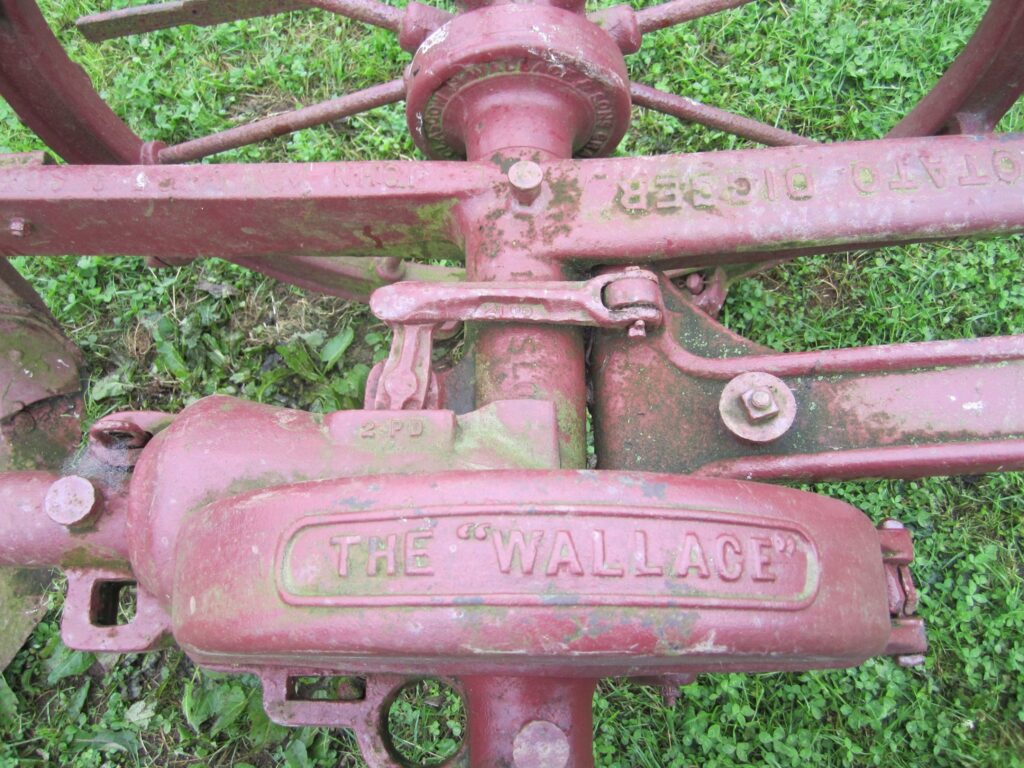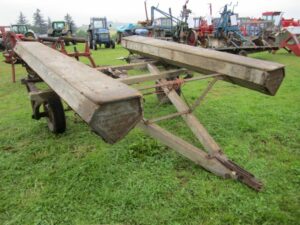W is for …
Walker & Templeton, 43 Portland Street, Kilmarnock, Ayrshire
D. M. Wallace & Sons Ltd, agricultural engineers and millwrights, Kelso
John Wallace & Son Ltd, Railway Bridge, Townhead, Ayr
John Wallace & Sons Ltd, agricultural engineers and implement makers, Graham Square; works and head office, Paton Street, Dennistoun, Glasgow
J. & R. Wallace, Foundry, Castle Douglas, Kirkcudbrightshire
Thomas Wallace & Sons (threshing machines and turnip cutters &c), Station Garage and 16 Bridgegate, Peebles
Watson Brothers (reapers, turnip drills, field rollers and harrows), Banff Foundry, Banff
Alex Webster (ploughs and harrows), Pluscarden, Elgin
Charles Weir, agricultural engineer, Strathaven, 451 Gallowgate, Glasgow and Kilmarnock (est 1632)
George Whitecross, 7 Reid Street, Banff, Banffshire
David Williamson & Sons, Cample Bridge, Thornhill, Dumfriesshire
Alex Wilson (Aberdeen) Ltd, engineers, Ashgrove Road Engineering Works, Ashgrove Road, Aberdeen
C. F. Wilson & Co., agricultural implement makers, 88 College Street, Aberdeen
David Wilson, implement maker, East Linton, East Lothian
Thomas Wilson, agricultural implement maker, Chapelton, Lanarkshire
William Wilson & Son (Crosshouse) Ltd, Plann Saw Mills, Crosshouse, Ayrshire
Wright Brothers (Boyne Mills) Ltd, Boyne Mills, Portsoy, Aberdeenshire
We have some really big names under W.
Most notable are members of the Wallace Family of Glasgow and Ayr. The family were key players in the development of the company. In 1896 they included James Wallace, William Wallace, Robert Wallace, John Wallace, William B Wallace, and John F. Wallace. They included notable figures in the implement and machinery trade, as well as the wider community in Glasgow. The Scottish Farmer highlighted some the qualities of William Wallace in an obituary on May 18, 1912. It reads:
The Wallace family were key players in the development of the company. In 1896 they included James Wallace, William Wallace, Robert Wallace, John Wallace, William B Wallace, and John F. Wallace. They included notable figures in the implement and machinery trade, as well as the wider community in Glasgow. The Scottish Farmer highlighted some the qualities of William Wallace in an obituary on May 18, 1912. It reads:
“While this is important in recording the great William Wallace’s achievements, it also provides a good deal of information about his role within the wider public life of Glasgow, and the important contribution that he made to it. It also sets out some of the wider history of the eminent firm of John Wallace & Sons, and the wider role of the family within Scottish and world agriculture.
“Mr William Wallace, J.P.
Throughout the agricultural world there will be abiding sorrow at the tidings of ex-Bailie William Wallace, managing director of the well-known firm of John Wallace & Sons (Ltd), implement makers and agents, Glasgow. Mr Wallace was for many months a sufferer, and he might have said that he had suffered many things of physicians, and had been little the better. He passed away on Monday, 13th inst., in his own home, 5 Oakley Terrace, Dennistoun, Glasgow, aged sixty-five.
Mr Wallace belonged to an old Ayrshire family, hailing from the parish of Fenwick. He was born in Dalkeith while his father was foreman in Mushatt’s Foundry in that town. Subsequently Mr John Wallace removed to Mill of Haldane, in Kilmaronock parish, Dumbartonshire. There he kept the local “smiddy”, and developed that skill in handling agricultural machinery and implements which eventually went to the establishing of the reputation of his firm as one of the foremost in that trade. At Mill of Haldane Mr William Wallace and his elder brother, Mr James, who predeceased him, were brought up, and made their first acquaintance with their future trade in the country “smiddy”. About half a century ago the family removed to Glasgow, and James and William joined their father in founding the firm that has long been in the front. Mr James Wallace devoted himself more to the mechanical side of the business, and was therefore not so well known publicly as his brother. Mr William Wallace for many years was the representative of the firm at all the principal shows, and in many of the chief market towns. He was a first-rate business man, a good salesman, with a fine commercial instinct, and honourable and straightforward to a degree. Possibly there was in broad Scotland no better known or more widely respected member of the implement trade. A life member of the principal agricultural societies, he frequently was chosen as the spokesman of his trade when arranging details with these institutions. He also devoted much time and attention to the work of the Glasgow Agricultural Society, of which he was for various terms a director.
In 1902 Mr Wallace entered the Glasgow Town Council, and soon won a foremost place in its committees. He was not fond of public speaking, but when occasion required he could give quite a good account of himself at the Council board. His best work, however, was done in committee, and so highly were his qualities esteemed that after a comparatively short probation he found his way to the bench. As a magistrate, Bailie Wallace shone. He was essentially a man of kindly disposition, and aimed at being just. On the bench these qualities had full play, and he was held in much esteem as one of the best of the citizen magistrates. Identified throughout his life with the total abstinence movement, his experiences as a magistrate confirmed him more and more in the belief that the liquor traffic was prejudicial to the best interests of society. If possible, his total abstinence principles became more pronounced as he advanced in years, and in connection with that matter he was well known to be one of the temperance stalwarts in the licensing bench. He was a representative of the Town Council on the governing bodies of the West of Scotland Agricultural College and the Glasgow Veterinary College, and he also devoted much attention to the affairs of the Scottish Labour Colony.
Altogether, Bailie Wallace spent a worthy, noble life, working for the good of his fellow-men, and in business relationships securing the cordial goodwill of customers and competitors. He was universally recognised as a “white man”, one who played the game, and never feared either to express his opinions or to act up to them. He is survived by Mrs Wallace, who was in all points a most worthy helpmeet, and their family of four sons and one daughter. Two of the sons-Messrs John F. and Duncan-are in the form of John Wallace & Sons (Ltd); one-Mr Wm B. Wallace, formerly farmed at Broomhouse, Corstorphine, and is now farming in Surrey; and the fourth is in South Africa. To Mrs Wallace and her family we tender our respectful sympathy. The funeral, which was private, took place on Thursday to Janefield Cemetary, Glasgow.”
The name of John Wallace & Sons is a well-known and long established one among the Scottish agricultural implement and machine makers.
The company was already trading in Glasgow in 1865, from Graham Square. Graham Square was to form the address of the company until the late 1960s. By 1894 it had premises at 7, 9, 10 and from 28 to 38 Graham Square. By 1905 there were also branches at Ayr, Cupar, and Stirling; in 1913 they were recorded as Ayr, Perth, Cupar and Lanark.
The company was a forward looking on: it became a company limited by guarantee in December 1896; it changed its form a number of times during its history. It started to exhibit at the Highland Show in 1867, and attended shows in each of the different show districts, demonstrating its wish to be a company known throughout Scotland. The Highland and Agricultural Society awarded it numerous awards for its manufactures including a medium silver medal for collection (1870, 1875). It also won a number of awards at the Society’s prestigious implement trials, including third prize of £5 for potato digger in 1881, and equal award (with 3 others) for potato digger or lifter in 1911. It also entered a number of the Society’s trials including its trial of mowers in 1882, trial of binders in 1893, turnip lifters in 1895, swathe turners in 1905, potato diggers or lifters in 1909, potato diggers or lifters in 1911, and potato planters in 1914. The company regularly advertised in the Scottish agricultural press from 1864 onwards.
A key episode in the history of the business took place in December 1896 with the formation of the limited company of John Wallace & Sons Ltd. Its certificate of incorporation was dated 13 December.
The company’s memorandum of association provides insights into the newly formed company and how it was to operate:
“The objects for which the company are established are:
(a) to acquire the business carried on in Glasgow and elsewhere under the name or style of John Wallace & Sons, agricultural engineers and implement makers, Graham Square, Glasgow, and to purchase and undertake the whole of the assets and liabilities of such business upon the terms set forth in an agreement between the said John Wallace & Sons on the one part and James Colquhoun LLD, writer, Glasgow, as trustee for this company, on the second part, dated the twenty-sixth day of December, 1896.
(b) to carry on business as agricultural and general engineers, millwrights and implement makers, and ironmongers, in Glasgow and elsewhere, and to make, buy, sell, produce, alter, and deal in agricultural implements of every kind and description, and generally to carry on any business of a character similar or analogous thereto, or which will contribute to or facilitate the same, or which, by the advance or increase of knowledge or exigencies of labour, may be substituted therefor.
(c) to manufacture and sell, either by wholesale or retail, every description of goods connected with the agricultural industry of the country, and for that purpose to acquire suitable premises, either by building or purchasing the same, and to lease or buy, sell or exchange, land, or land and buildings, free from or subject to any feh-duty, ground, annual rent, tax, reservations of mines and minerals, or any restrictions, conditions, and agreements whatsoever, or subject to any bond, mortgage, or charge or other encumbrance. …”
The capital of the company was to be £40,000, divided into 8,000 shares of £5 each. The first directors were James Wallace, agricultural implement maker, and William Wallace, agricultural implement maker, both of Glasgow.
In this form the company continued until 1920. On 16 July 1920 the company passed a special resolution to wind up the company; this resolution was confirmed on 2 August 1920. Thereafter, the company took on another form, using the same name.
In the early 1940s the company had a business that extended throughout the major agricultural districts of Scotland. In 1942 an advert in the Scottish Farmer noted that the Glasgow based company (at Dennistoun) had branches at Perth, Aberfeldy, Edinburgh, Cupar, Laurencekirk, Wishaw, Carlisle, Oldham and Welwyn Garden City. By 1947 the company was listed as being at Glasgow and Welwyn Garden City and as having branches at Perth, Aberfeldy, Edinburgh, Cupar, Laurencekirk, Wishaw, Dumfries, Carlisle and Oldham. In 1952 the company’s branches were at Perth, Cupar, Stirling and Laurencekirk.
There were changes in how the company presented itself and how it was structured. There were a number of companies set up under the Wallace name.
By 1961 the company had changed its name to John Wallace & Sons (Agricultural Engineers, Glasgow) Ltd. It was to become John Wallace Agricultural Machinery Ltd after its incorporated on 23 November 1965 (and dissolved on 5 December 1973). An advert in the Farming News on 14 May 1965 noted that “John Wallace & Sons (A. E. G.) Ltd announce that the name of the company has been changed to John Wallace (Agricultural Machinery) Ltd, and are now operating from their new headquarters at Shell Park, Stirling. As previously announced spare parts enquiries are to be made to John Wallace Spares Division, Alloway Road, Maybole.
In addition, John Wallace Engineering Ltd was incorporated on 10 July 1964 (and dissolved on 30 December 1975). Further, John Wallace Farm Equipment Ltd was incorporated on 3 February 1965 (and dissolved on 30 December 1975). John Wallace Farm Equipment East Limited was incorporated as Thomas Sherriff & Company Ltd on 23 September 1941. Its parent company There was also a John Wallace Chemicals Ltd.
By the late 1960s John Wallace (Engineering ) Ltd was a holding company with 8 directors, and 2 shareholders, whose principal activity was the investment in and management of companies engaged in general engineering. In 1967 the subsidiary companies included Polarcold Ltd, Associated Metal Works Glasgow Ltd, Crawford Machinery Co. Ltd, John Wallace Mechanical Handling Ltd, Trucks & Pallets Scotland Ltd. All was not, however, well on the trading side by late 1968. In its annual return for October 1968 the company had a trading loss of £45,000. From 1 April 1969 the company was no longer trading; it was under a patent company, Stenhouse Holdings Ltd, which was incorporated in Scotland. By 1973 this had become Stenhouse Industries Ltd. Wallace was dissolved by notice in the Edinburgh Gazette on 30 December 1975.
John Wallace Farm Equipment Ltd, with a registered office at Shell Park, Stirling, and then at St Vincent Street, Glasgow, had a number of wholly owned subsidiaries. These were A. Baird & Sons Ltd, Alexander Jack & Sons Ltd, Thomas Sherriff & Co. Ltd, and Praills Hereford Ltd. By 1968 the first three of these were dormant companies. by 1971 the company was no longer trading. It too was also under the ultimate holding company of Stenhouse Holdings Ltd.
John Wallace Farm Equipment East discontinued its business activities in January 1967 and by 31 March 1969 its assets had been substantially realised. It was also under the holding company of Stenhouse Holdings Ltd.
By the second half of the 1960s the companies faced tough trading conditions – like the other Scottish implement and machine makers. A good many of them went under, including leading names like that of Wallace of Glasgow. Its company records show an interesting connections between companies as well as different business models and types of management.
By 1904 John Wallace & Co., had a premises at Ayr, at the Agricultural Implement Works, Railway Works, at Townhead. This Ayrshire branch was later to become a company in its own right under the name of John Wallace & Sons (Ayr) Ltd which continued in business until at least 1967; it was not dissolved until 30 August 1985. Its company limited by guarantee status came in 1949.
By 1934 the company had a number of premises in Ayr, and not only at Townhead Works. There were further ones at Smith Street and Station Bridge. In 1928 it had opened premises at Kilmarnock, at West Langlands Street. In 1944 it also had a premises at Stranraer.
In 1938 the company was known for its reapers, mowers and double drillers and manure sowers. It held a number of agencies. In 1942 they included John Deere and Caterpillar. Three years later they included Massey-Harris, Bamfords, Wallace, Oliver, David Brown, Ransomes and R. A. Lister. 1966 these included Ford and Ransomes.
C. & J. Weir, was a partnership known in the town of Strathaven, in 1882. By 1885 that partnership had dissolved and Charles Weir announced his business as millwright and engineer in the North British Agriculturist, the national Scottish agricultural newspaper. Two years later he gave his address as the agricultural implement works, Strathaven. Charles Weir of Strathaven was a name that became well known in the west of Scotland – it had a Glasgow depot from 1906 – and beyond until 1973. From 1934 the company became a company limited by guarantee, as Charles Weir Ltd.
The Weir family went much further back than 1882. In 1925 Charles Weir announced in the Scottish Farmer that it had been established since 1632 – quite an engineering heritage. By 1885 the company descibed itself as a millwright and engineer. These were two trades that were at the heart of the company’s skills and activities for decades. In 1936, for example, trade directories record the company as an agricultural engineer, an agricultural implement maker and agent, an agricultural implement manufacturer, and millwright. By 1955 another one describes the company as also a dairy appliance manufacturer.
While the company was old established, it did not promote its manufactures at the Highland Show until 1912, and only thereafter sporadically until 1958. The most frequent decade for its attendance was the 1930s. From 1914 it was also a regular advertiser in the Scottish Farmer.
The company’s stand at the Highland Show in 1912 provides an insight into its activities: its manufactures as well as its agencies. It exhibited:
– threshing mills, with comb drum, extra long crank shakers, riddle and sieve in motion;
oil or petrol engine driving threshing mill or churn;
– churn, 65 gallons, streamlet churn for power;
– churn, 25 gallons, streamlet churn for hand power;
– Weir’s patent rick lifter for hand power;
– Weir’s new patent rick lifter for hand or horse power;
– chain pump for liquid manure, sample to lift 10 feet (any size supplied to order);
– horse hoe or scarifier, extra long, with improved side stays;
– cheese press, double cheese press, new improved, with cut screws and brass nuts;
– curd mill, new improved, with malleable grating;
– meat cooler, 100 gallon, galvanised with malleable wheels;
– fodder barrow, large size, galvanised with malleable wheels;
– drill roller, notched drill roller;
– barn fanners, with 4 riddles and sand sieve;
– sack barrow, sack truck or barrow, varnished;
land roller, 6 ft wide by 33 inch diameter and steel covered;
– new patented, “Orwell” cultivator, 7 tines;
– “Albion” grinding mill;
– “Albion” chaff cutter for hand or power;
– weighing machine, sack weighing machine with weights;
– “New Century” latest improved binder;
– Wood’s famed non-frame mower, right or left hand;
– Wood’s new admiral mower;
– reaping attachments for above mowers;
– hay tedder, all steel, strong make;
– hay rake, all steel, strong make;
– Walter A Wood’s spring tooth harrows, with patent adjusting clip, 15 tines;
– garden seat, wood sparred and varnished, with malleable supports.
The list includes wide variety of manufactures. But it is also a range specifically for a predominantly livestock and dairying district: churns, as well as haymaking machinery, andmachiens for processing grains for animal food.
The company was also embracing the latest implements and machines from reputable companies such as Walter A. Wood, from the States and also England, as well as Harrison, McGregor of Leigh. His own manufactures, apart from the threshing machines, would have been relatively easy to manufacture.
Farmers and other agriculturists in north-east Scotland would have been well-aware of the renowned firm of G. W. Murray & Co., of the Banff Foundry, until it gave up business in 1897.
The Banff Foundry was not to remain empty for any length of time after G. W, Murray gave up business. By 1898 Watson Brothers had started business in it. In its first year of business it advertised itself as “Watson Brothers (successors to G. W. Murray & Co.) Banff Foundry.”
The Banff Foundry was not to remain empty for any length of time after G. W, Murray gave up business. By 1898 Watson Brothers had started business in it. In its first year of business it advertised itself as “Watson Brothers (successors to G. W. Murray & Co.) Banff Foundry.”
The company had a number of trades: an agricultural implement maker, iron founder, iron merchant, marine engineer, mechanical engineer, and pump maker. Its main lines of manufacturers were reapers, turnip drills, field rollers and harrows. It extended its manufacture of corn bruisers in 1904 after purchasing the entire stock of corn bruiser patterns from Dalgetty Brothers, Aberdeen.
In 1909 the brothers were reported in the local Aberdeen Daily Journal to have “had a rather busy spring, and the demand for their standard implements, such as broadcast grain sowers, rollers, turnip drills, and horse hoes has been well maintained. In regard to harvest machinery the demand for the Milwaukee blunders was in excess of all previous years, while the Victory, which has been fitted with an improved cutting bar, has given an excellent account of itself. The export department has been particularly busy, the shipments to Rhodesia and Africa generally having been almost double those of the previous year. The iron punching and shearing machines for the use of small engineers have been going off in quite large numbers. During the year six new drifters were fitted out with engines, and although there has been a lull in this department, a good few orders have been booked, the work to be carried out during the forthcoming spring. The firm’s moulding shop has been reproofed, and the fitting shop has been extended to the full extent of the available ground, which will permit of traction engines being taken under cover. A travelling crane is another of the improvements which is to be carried out at the works, and will enable heavy castings to be moved about with ease.” (30 December 1909),
As well as making its own implements, it also acted as an agent. In 1908 they included Ransomes, Sims & Jefferies of Ipswich and in 1911 International Harvester Co. of Great Britain Ltd, London.
Its main area of business was in the north-east. Indeed, at the Highland Show it only exhibited at largely the Aberdeen and Inverness shows. It attended the 1898 show at Kelso, its first year of business.
Watson Brothers continued to occupy the Banff Foundry until 1924 when William Watson died.
